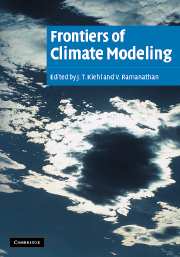Book contents
- Frontmatter
- Contents
- Preface
- List of Contributors
- Acknowledgments
- 1 Overview of climate modeling
- 2 Climate-change modeling: a brief history of the theory and recent twenty-first-century ensemble simulations
- 3 Energy-balance climate models
- 4 Intrinsic climatic variability: an essay on modes and mechanisms of oceanic and atmospheric fluid dynamics
- 5 The radiative forcing due to clouds and water vapor
- 6 A model study of the effect of Pinatubo volcanic aerosols on stratospheric temperatures
- 7 Unresolved issues in atmospheric solar absorption
- 8 Cloud feedbacks
- 9 Water-vapor feedback
- 10 Water-vapor observations
- 11 New frontiers in remote sensing of aerosols and their radiative forcing of climate
- 12 Cloud–climate feedback: lessons learned from two El Niño events
- 13 Runaway greenhouses and runaway glaciations: how stable is Earth's climate?
- Glossary
- Plate section
12 - Cloud–climate feedback: lessons learned from two El Niño events
Published online by Cambridge University Press: 12 August 2009
- Frontmatter
- Contents
- Preface
- List of Contributors
- Acknowledgments
- 1 Overview of climate modeling
- 2 Climate-change modeling: a brief history of the theory and recent twenty-first-century ensemble simulations
- 3 Energy-balance climate models
- 4 Intrinsic climatic variability: an essay on modes and mechanisms of oceanic and atmospheric fluid dynamics
- 5 The radiative forcing due to clouds and water vapor
- 6 A model study of the effect of Pinatubo volcanic aerosols on stratospheric temperatures
- 7 Unresolved issues in atmospheric solar absorption
- 8 Cloud feedbacks
- 9 Water-vapor feedback
- 10 Water-vapor observations
- 11 New frontiers in remote sensing of aerosols and their radiative forcing of climate
- 12 Cloud–climate feedback: lessons learned from two El Niño events
- 13 Runaway greenhouses and runaway glaciations: how stable is Earth's climate?
- Glossary
- Plate section
Summary
Introduction
As shown in Chapters 5 and 8, clouds as one of the moist fluid dynamical phenomena play a subtle role in Earth's climate. Clouds act as a greenhouse ingredient to warm Earth; they also reflect solar radiation to space to cool Earth. The net radiative effect of these two competing processes depends on the amount, height, type, and the optical properties of clouds. All these characteristics vary in a climate change. Clouds thus exert a feedback to any forced climate change (see Chapter 8). This cloud–climate feedback problem was first studied by Schneider (1972) and Cess (1975). Later, it was found by Cess et al. (1989) that a difference in cloud–climate feedback contributes to a three-fold difference in the sensitivity of a large group of general circulation models (GCMs). At the same time, Mitchell et al. (1989) showed that different treatments of clouds in the GCMs can lead to either amplification or damping of the global-warming scenario in response to the increasing level of carbon dioxide in the atmosphere. These studies stimulated much subsequent research on this topic and they helped to initiate national programs such as the Atmospheric Radiation Measurement (ARM) Program of the Department of Energy.
Cloud-radiative forcing (CRF), first introduced by Charlock and Ramanathan (1985), can be conveniently used to quantify the radiative impact of clouds. It is defined as the influence of clouds on the input of radiant energy to the Earth–atmosphere system at the top of the atmosphere (TOA).
- Type
- Chapter
- Information
- Frontiers of Climate Modeling , pp. 332 - 348Publisher: Cambridge University PressPrint publication year: 2006



